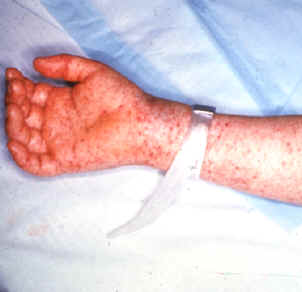|
Rocky Mountain Spotted Fever Home > Signs and Symptoms
Signs and Symptoms
Rocky Mountain spotted fever can be very difficult
to diagnose in its early stages, even by experienced
physicians who are familiar with the disease.
Patients infected with R. rickettsii generally
visit a physician in the first week of their illness, following an incubation
period of about 5-10 days after a tick bite. The early clinical
presentation of Rocky Mountain spotted fever is nonspecific and
may resemble a variety of other infectious and
non-infectious diseases.
The classic triad of findings for this disease are
fever, rash, and history of tick bite. However, this
combination is not always detected when the patient
initially presents for care.
Initial Signs and Symptoms
 |
| Early (macular) rash on sole of
foot |
Initial symptoms may include fever, nausea, vomiting, severe headache, muscle pain, lack of appetite.
The rash first appears 2-5 days after the
onset of fever and is often not present or may be very subtle when the
patient is initially seen by a physician. Younger patients usually develop
the rash earlier than older patients. Most often it begins as small,
flat, pink, non-itchy spots (macules) on the wrists, forearms, and ankles. These spots turn pale
when pressure is applied and eventually become
raised on the skin.
Later Signs and Symptoms
 |
| Late (petechial) rash on palm
and forearm |
Later signs and symptoms include rash, abdominal pain, joint pain, diarrhea.
The characteristic red, spotted (petechial) rash of Rocky
Mountain spotted fever is
usually not seen until the sixth day or later after onset of symptoms, and
this type of rash occurs in only 35% to 60% of patients with Rocky
Mountain spotted fever. The rash involves the palms or soles in as
many as 50% to 80% of patients; however, this distribution may not occur
until later in the course of the disease. As many as 10% to 15% of patients may never develop a rash.
Abnormal Laboratory Findings
Abnormal laboratory findings seen in patients with Rocky
Mountain spotted fever may include thrombocytopenia,
hyponatremia, or elevated liver
enzyme levels. See Laboratory Detection for more information on
laboratory confirmation of Rocky Mountain spotted fever.
Hospitalization
Rocky Mountain spotted fever can be a very severe illness
and patients often require hospitalization. Because
R. rickettsii infects the cells lining blood
vessels throughout the body, severe manifestations of
this disease may involve the respiratory system, central
nervous system, gastrointestinal system, or renal system.
Host factors associated with severe or fatal Rocky Mountain
spotted fever include advanced age, male sex, African-American
race, chronic alcohol abuse, and glucose-6-phosphate
dehydrogenase (G6PD) deficiency. Deficiency of G6PD
is a sex-linked genetic condition which occurs with
highest frequencies in people of African, Middle Eastern,
and Southeast Asian origin; it affects approximately
12% of the U.S. African-American male population; deficiency
of this enzyme is associated with a high proportion
of severe cases of Rocky Mountain spotted fever. This
is a rare clinical course that is often fatal within
5 days of onset of illness.
Long-term Health Problems
Long-term health problems following acute Rocky Mountain
spotted fever infection include partial paralysis of the lower extremities,
gangrene requiring amputation of fingers, toes, or arms or legs, hearing loss,
loss of bowel or bladder control, movement disorders, and language disorders. These
complications are most frequent in persons recovering from severe,
life-threatening disease, often following lengthy hospitalizations.
Date last reviewed: 05/20/2005 |